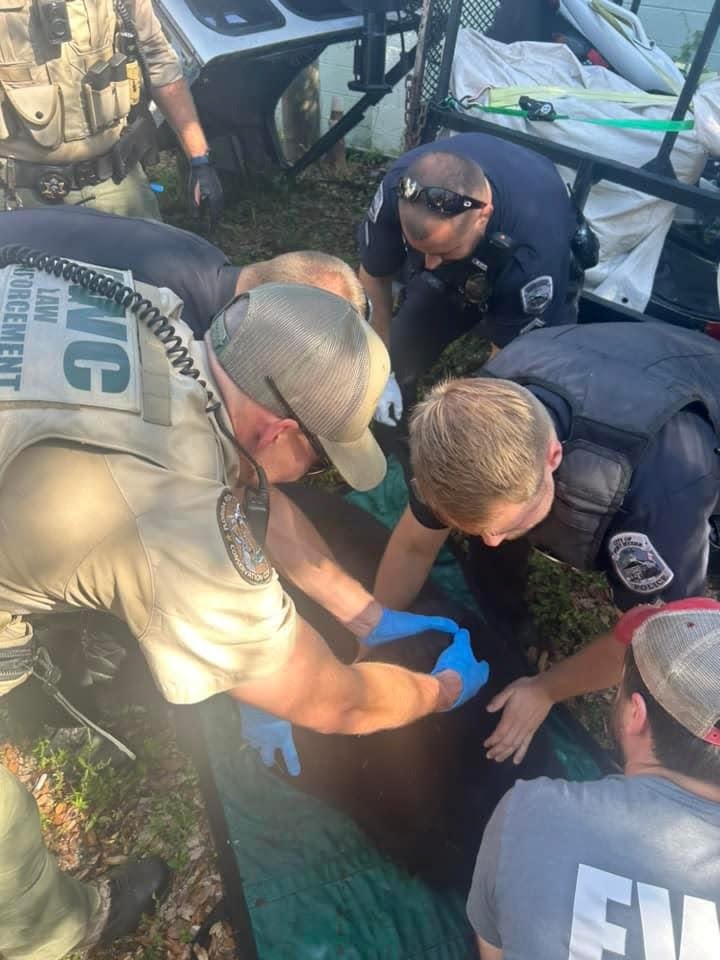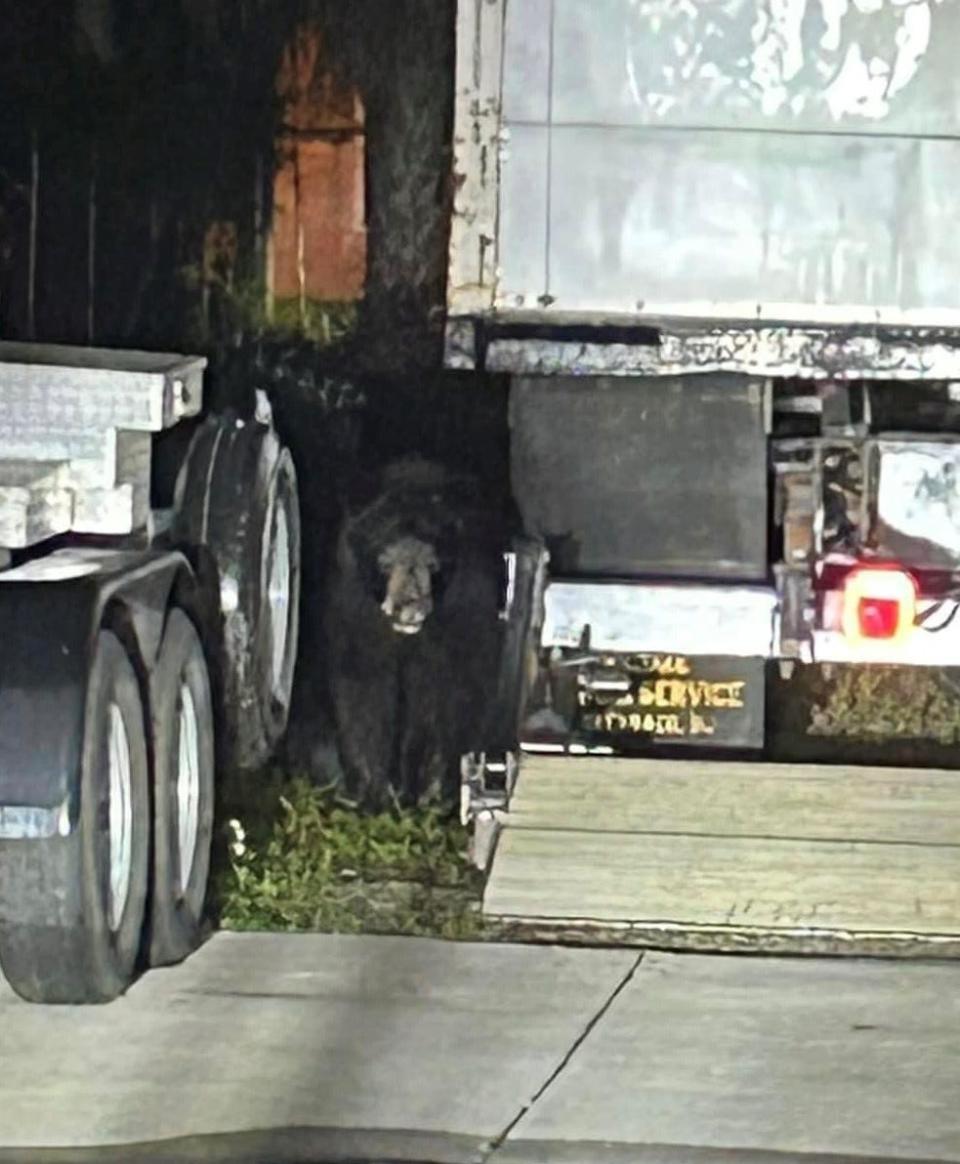What happens to a bear caught roaming the streets of downtown Fort Myers?

After surprising neighbors by climbing into a fenced parking lot, a bear out for an early morning stroll in downtown Fort Myers is on his way back to the country.
"Fort Myers Police are monitoring a black bear in the area of Broadway and Victoria Avenue," the PD announced on its Facebook page around 6 a.m. "Please avoid the area on foot, as we await Florida Fish and Wildlife to respond to relocate the bear."
An hour later, the department wrote: "The bear was safely tranquilized by FWC Biologists and will be monitored and relocated."
Officers first tried to lure the 350-pound male into a trap, according to media reports, but wound up using a tranquilizer dart fired from a nearby roof to quiet the bear so he could be taken to state lands.

Many questions remain; mainly where he came from. The nearest bear-scale wilderness is miles away, says wildlife biologist Maxx Chadwick, naturalist at Calusa Nature Center and Planetarium in Fort Myers. He can't remember hearing of bears even using the nonprofit's 105 acres in the past. "It's weird," he said.
That's not to say it doesn't happen, and when it does it is often young males that wander into town after reviving from their winter slow-down.
In 2020, a 250-pounder turned up in the industrial area near the Cement Industries plant off Metro Parkway and the following year, a little one weighing in at about 100 pounds made his way from Fowler Street to Earl Road near Page Field.
More: Doughnuts prove irresistible to bear on the loose in downtown Fort Myers
But females roam in the spring as well, including female bears that are teaching their cubs where to look for food, says FWC's Lisa Thompson. "To prevent bears and other wildlife from associating your yard with an easy meal, remove potential food sources and attractants – such as unsecured garbage, pet food and bird seed – from around your property. Florida black bears typically try to avoid people but may linger in neighborhoods if they can easily access food sources. Bears will move on if they can’t find food."
Though black bears aren't usually aggressive, it's not unheard of. "Dogs in particular can trigger defensive behaviors from bears, especially females with cubs," Thompson wrote in an emailed release. She recommends walking dogs on a short leash and before letting your dog out, flipping exterior lights on and off and banging on the door to give bears and other wildlife a chance to leave the area.
Bears also cross more roads at this time of year, usually at dawn and dusk, leading to some 250 vehicle strike deaths per year, which slowing down might help prevent, she says.
How to safely live among bears
In addition to securing attractants like garbage, pet food and wild bird food, the FWC urges the public not to approach a bear if they see one, and to keep a safe distance. If you do encounter a bear at close range, do not run. Remain standing upright, speak to the bear in a calm, assertive voice, and back up slowly while leaving the bear with a clear escape route.
Report human-bear conflicts to the FWC’s Southwest Regional Office at (863) 648-3200.
For more information about the Florida black bear, please visit myfwc.com/bear.
Q&A with the FWC about bears
The News-Press sent Hailee Seely, FWC public information director for the southwest region, a list of questions, which she coordinated with staff to get answered.
Any idea where this bear might have come from? The nearest preserve is pretty far off. Though sightings in urban areas are uncommon, Florida black bears may be seen anywhere connected to rural areas in southwest Florida. You can view statewide bear sightings with this interactive map.
Can bears survive in urban areas on the down-low? It seems like it’d be hard to stay concealed. Bears and other wildlife that linger in urban areas are a symptom of the problem of wildlife having easy access to human-provided foods, which are often much more calorically dense than natural forage. If the unsecured food source—garbage, compost piles, livestock, and pet/livestock/bird foods—are eliminated, the problem is eliminated. Bears will move out of the area to search out another food source.
How far can they wander away from their home area? In Florida, average annual adult home ranges for bears are 50 to 120 square miles for males, and 10 to 25 square miles for females. The size of a home range may vary each season and year depending on food availability, the bear's sex or age, the reproductive status of the bear, and even the density of the area's bear population. During major droughts and famine, bears will range much further than normal to search for food. Bears are excellent swimmers and will frequent nearby islands during seasonal and climatic changes.
How much ground can they cover in an hour? Between the ages of 1½ -2½ years, juvenile or yearling bears start dispersing in spring and summer, with spring marking a return to activity for bears after limited movements in winter. During this time, juvenile bears may be seen in unexpected areas as they travel across a wide range of areas in search of a new location to settle down. Dispersing bears are “on a mission” to seek a new home range and may travel many miles in a day. Black bears walk flat-footed, just like people, with all 5 toes on the ground. While they may look slow because of their shuffling gait, black bears can sprint at up to 35 miles an hour for brief stretches.
Bears in Florida don’t hibernate per se, right? How do you describe their quiet period and when does it end? Hibernation is the state in which an animal’s metabolic and physical activity is reduced. You may also see it called denning, torpor, and carnivore lethargy. During this time, bears do not need to eat, drink, urinate, or defecate. This period of reduced activity occurs in all black bear populations. Hibernation is brought on by many factors, including reproductive status, amount of daylight, and temperature change and, most importantly, food availability. However, it is notable that bears in southern states den for shorter periods and sleep less deeply than bears in colder climates. While denned bears in northern states are very lethargic and less responsive to people, bears in the South may readily run away if they are disturbed. In addition, male bears in southern states like Florida may have a reduced denning period or none at all but will exhibit lethargic behavior.
How much food/how many calories do they need a day at this time of year? During the summer months, bears eat about 5,000 calories a day. Roughly 80 percent of a black bear’s diet comes from plants (e.g., fruits, nuts, berries), 15 percent from insects (e.g., termites, ants, yellow jackets) and 5 percent from meat (e.g., opossums, armadillos, carrion).
What’s the current bear population estimate in Florida? Approximately 4,050.
This article originally appeared on Fort Myers News-Press: Florida black bear who turned up near City of Palms Park moved

